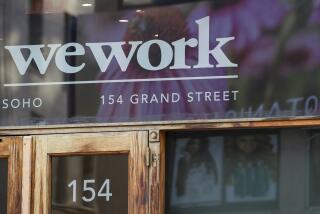Moody’s Downgrades Xerox Bonds to Junk Status
- Share via
NEW YORK — Xerox Corp.’s credit ratings were cut by Moody’s Investors Service Inc. to junk status Friday, making it more difficult for the troubled copier giant to handle its $11-billion debt load.
The action was one of the largest downgrades to junk status in U.S. history and represents a symbolic milestone in the onetime blue chip company’s deterioration this year.
Indeed, the company’s shares tumbled Friday to a new low on the New York Stock Exchange, down 69 cents to $6.25. All of the 9.9% decline came after the downgrade.
Xerox’s worsening financial condition has prompted questions about the firm’s very survival, though the company insists those concerns are overblown.
The debt downgrade means that many investment funds will no longer be able to own Xerox debt because it fails to meet investment-grade standards. Although Xerox has already stopped issuing commercial paper, the downgrade will increase pressure on the company to redress its financial problems.
Xerox Chief Executive Paul Allaire expressed disappointment with the downgrade, saying the company’s turnaround plan, which includes asset sales and cost cutting, remains on track.
Xerox, a brand name whose roots date to the 1940s, has struggled in its efforts to transform itself from a maker of free-standing copiers to a maker of digital printers connected to computer networks.
Moody’s said its action “reflects concerns about liquidity,” as well as Xerox’s expected heavy reliance on asset sales to run its business and pay down debt maturing next year. The credit rating agency also expressed concern about Xerox’s weakened earnings and cash flow.
Moody’s cut its long-term senior unsecured ratings for Xerox and various units to “Ba1,” its highest junk grade, from “Baa2,” and its commercial paper ratings to “Not Prime” from “Prime-2.”
Its rating outlook remained negative, reflecting Xerox’s strained liquidity and “uncertainty” over management’s ability to restructure its operations in the face of slowing demand.
Allaire said in a statement that “the downgrade is disappointing in light of our previously communicated turnaround plan, which is on track.” He added that Xerox is “confident” its financial stability will return.
Bondholders were less certain on Friday.
Xerox’s 5.5% notes maturing in November 2003 and Xerox Capital Corp.’s 5.875% notes maturing in May 2004 attracted no bids after the downgrade, traders said. Dealers were offering the bonds at 59 and 57 cents on the dollar, respectively, 7 cents lower than before the downgrade.
Before the downgrade, the bonds were already trading like junk, being quoted by price instead of their yield premium relative to safer U.S. Treasuries.
Xerox said in October that its doors to the commercial paper market had temporarily closed, and that it had $2.2 billion remaining under a $7 billion credit line maturing in 2002. As of Oct. 31, the company had borrowed $5.3 billion on that line, Moody’s said.
“It is using its current bank facility a lot until it sells assets, and there is some event risk here,” said Kingman Penniman, president of KDP Investment Advisors Inc. in Montpelier, Vt. “They have to sell assets in order to reduce leverage.”
Xerox also has about $1.1 billion of debt maturing by year’s end and $2.5 billion more next year, Moody’s said. As a result of the downgrade, the company may have to repurchase $110 million of derivative contracts and repurchase $315 million of accounts receivable.
Christa Carone, a Xerox spokeswoman, said after the downgrade that the company is negotiating to receive additional financing.
Xerox has said it hopes to realize $2 billion to $4 billion from asset sales, and $1 billion from cost cutting. It surprised analysts in October with a $128-million third-quarter loss, and warned it would lose money in its fourth quarter.
More to Read
Inside the business of entertainment
The Wide Shot brings you news, analysis and insights on everything from streaming wars to production — and what it all means for the future.
You may occasionally receive promotional content from the Los Angeles Times.










